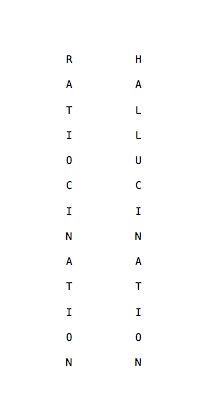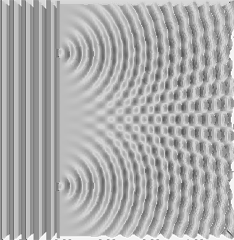
Through a Double Slit
As we divide, chop and zoom infinitesimally smaller toward the Planck length, the measurement of one angstrom, one ten billionth of a meter (10-10)—about the size of a atom—seems also to be a certain fulcrum or waistline in the hourglass of space-time. This is where quantum effects become significant and where the explanations physicists propose for them only seem to cause reality to multiply.
Many iterations of the “double-slit experiment” have been used to demonstrate various and changing attributes of light over the last two centuries. In early versions, monochromatic light was directed at a barrier with two parallel slits in it. On a screen on the other side of the barrier, where one might have expected to see two bars of light that correspond to the slits, what was actually cast on the screen were alternating stripes of light and shadow. This was explained as an interference pattern in which the beams of light, after passing through the slits, interfere with one another to cause multiple lines of light. When two more slits were cut in the barrier, fewer lines of light appeared on the other side. Initially, this demonstrated that light propagates as a wave: when it passes through the slits, the light wave divides into two waves with very similar wavelengths, and as these superpose, the slight difference in their phases causes an interference pattern (visualized in the figure below), i.e., the light stripes on the screen are where the two waves hit in phase (the peaks and troughs of one wave match the peaks of troughs of the other) and the dark areas between are where the light waves hit out of phase (the peaks and troughs of the two waves do not match up).

Double-slit illustration, source: the Internet.
As the world was quantized, the wave theory alone no longer held. It seemed that light also had to operate as a series of units in order to explain certain anomalies and experimental observations seen by Planck and Einstein. By the late 1920s, the particle theory of light was accepted after Arthur H. Compton won the Nobel Prize for his particle “scattering” experiments.[1] Subsequently, It was postulated that particles in a group act as a wave, but then the same double-slit set-up was used again in order to test the experiment with individual photons. To do this, new technologies had to be invented: photon counters, coherent light sources attenuated down to low intensities (lasers), filters etc. Eventually, singular photons were fired at a barrier with two slits and after thousands of photons events were detected on the screen, the same interference pattern was again revealed—photons only hit the screen in particular places leaving gaps between more condensed areas, like the stripes of light and shadow in the early experiments. This lead to what is called “wave-particle duality,” an attempt to reconcile the inability of either prior theory to explain quantum behavior. The wave and particle theories of light contradict, yet both are needed to explain observations made at this cropped down scale.

Wave-particle duality, animation: Thierry Dugnolle, source: Wikimedia Commons
Wave-particle duality has become a staple concept in quantum mechanics as double-slit experiments (and other similar interferometer experiments) performed with electrons, protons and neutrons (unlike photons, these particles have mass) all display the same interference pattern results.[2] Yet just stating that two explanations are needed for different observations does not satisfy quantum theorists. What causes interference in experiments with singular particles? What gives particles this wave function? While attempts to answer these questions do reveal that only one photon at a time goes through one of the slits, they also pose new conundrums. Wendy Flavell, Professor of Surface Physics at the University of Manchester, said in an interview on BBC 4’s In Our Time, “If we do experiments were we actually measure which slit the single photon goes through, which we can now do, the interference pattern disappears. But if we don’t measure which slit the single photon goes through, we have an interference pattern. If we do what are called quantum erasure experiments, where we do measure which way the photon goes through the slits and then we just erase that information, the interference pattern comes back.” Grappling with these observations leads physicists to particularly imaginative strains of logic.
David Deutsch insists that there must be some invisible attribute of particles that cause interference. He refers to the invisible interference-causing entities as “shadow particles” and notes, “each of these shadow particles is detectable only indirectly, through its interference with the motion of its tangible counterpart.” Deutsch rationalizes that these experiments “rule out the possibility that the universe we see around us constitutes the whole of reality,” and that, “the objects and events that we and our instruments can directly observe are the merest tip of the iceberg” (1997, NP). But the chain of reasoning does not end there. Observing quantum interference phenomena in shadow patterns takes Deutsch from “shadow photons” to the notion of the multiverse. If every photon has a “shadow photon,” that shadow photon must also have a shadow photon and every one of those shadow photons must exist in its own shadow universe. Deutsch says, “In fact the whole of physical reality is a multiverse that contains vast numbers of parallel universes” (1997, NP) complete with shadow Davids and parallel Procrusteses.[3]
[1] Compton’s proof of light quanta is explained in an easily understandable article from 2004 by David C. Cassidy called, “Focus: Landmarks: Photons are Real,” published for Pysical Review’s online archive. Source: http://physics.aps.org/story/v13/st8
See also Arthur H. Compton’s paper “A Quantum Theory of the Scattering of X-rays by Light Elements.” Source: http://dx.doi.org/10.1103/PhysRev.21.483
[2] It is interesting to note the role of commercial tech companies in the funding of such experiements. See the video published by Hitachi on Dr. Tonomura experiments with electrons.
https://www.youtube.com/watch?v=mypzz99_MrM
https://rdg.ext.hitachi.co.jp/rd/moviee/doubleslite-n.wmv
[3]Derivatives of this theory still stand and their mathematic models can, at least qualitatively, reproduce quantum behavior. In late 2014 Michael J. W. Hall, Dirk-André Deckert and Howard M. Wiseman published a convincing paper on their many interacting worlds (MIW) approach to quantum mechanics; an approach in which “all quantum effects are due to interactions between a large but finite numberN of worlds.” Phenomena such as the interference in double slit experiments “are shown to be consequences of the mutual repulsion between worlds” (2014, p. 14).
Source: http://journals.aps.org/prx/abstract/10.1103/PhysRevX.4.041013
Table of Contents
Scale
Vanishing Exercise
Imagination
Procrustes
Through a Double Slit
No Dreams, No Logic
Erotics of Art and Science
Bibliography
Extra

No Dreams, No Logic, 2015
LED strip lights, foam board, fabric, slide projector, oscillating fan
1.33 x 1.21 meters
Home-Work, Geneva, CH.